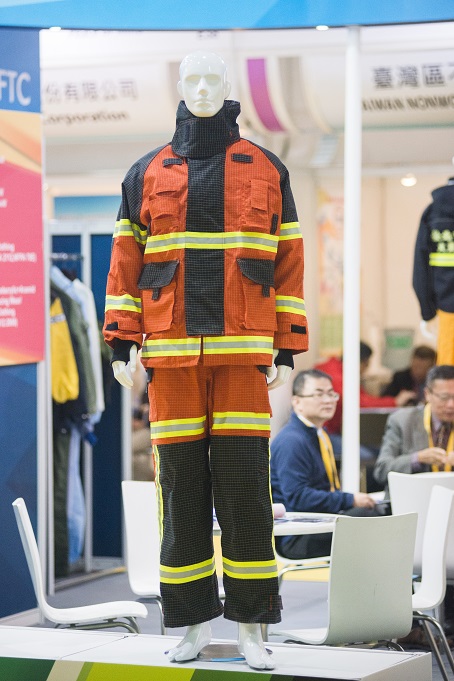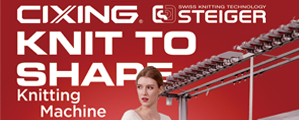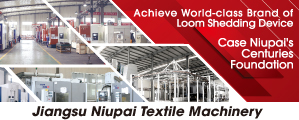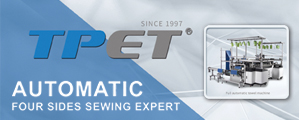Status quo of China’s industrial textiles industry in the first three quarters in 2017
Jan 15, 2018 | by

The present industrial textiles industry in China is centered on technical innovation and consumption upgrading, so as to intensify the strength in product development and innovation of technical processing equipment, enhance enterprise management, reduce cost and improve efficiency. After overcoming various adverse factors, the industry maintained stable growth in the first three quarters
Steady growth of the output of main products
According to the data of National Bureau of Statistics, the outputs of the non-woven fabrics and cord fabrics in the above-designated enterprises in China were 3.3468 million tons and 0.6498 million tons respectively, with the year-on-year growths of 0.64% and 3.47% respectively. It is worth keeping an eye on that: in recent years, the output of non-woven fabrics in China has witnessed fast growth. As the continuous increasing of cardinal number, the growth speed is slowing down gradually. However, the export amount of the non-woven fabrics keeps in growing. The customs data displays that the export amount of the non-woven fabrics had a growing speed of 6.15% in the first three quarters. The export volume of other main products also grew steadily. The export volume of coated fabrics grew by 6.52%; the wiping cloth grew by 11.72%; the felt and tent grew by 17.78%; the diaper and sanitary towel grew by 13.43%; the air bag restraint system grew by 7.3%. However, the export volume of some traditional products had declining in different degrees. For example, the textile products for packaging declined by 7.3%; the export quantity of the ordinary tape products declined by 6.28%. As a whole, the demand of China’s industrial textiles still kept on increasing steadily. However, the adjustment of demand structure enables the declining of the output of some products.
Recovery of industrial investment
The investment in industrial textiles industry presents a certain periodicity. The fixed-asset investment of the industry in the first three quarters of 2017 was 61.489 billion, which has extended the rising tendency since 2017. The year-on-year growth is 24.54%. The investment growth space further unfolds. The growing speed of industrial investment has went out of the declining channel of the recent years and recovered gradually.
The recovery of the investment acceleration in the industry in 2017 is because of the periodical regulation of the investment on the one hand. It indicates that the industry has basically consumed the increasing capacity of the previous years and has entered into a new round of investment climax. On the other hand, the stable and rising macro economic environment has also enabled the capital market to have better expectation to the industrial prospect.
Observing from different fields, non-woven fabrics are still the investment hot points of the industry. The investment amount of the first three quarters reached RMB27.948 billion, with a year-on-year growth of 29.27%. The investment in rope, cable and cord still maintained the vigorous momentum of the first half year, with a year-on-year growth of 57.31%. The investment in sail and canvas increased 17.96%. However, the investment in spinning band and cord fabrics continued to decline, with a year-on-year declining of 18.12%.
While the industrial investment continues to rise, the average asset-liability ratio of the industry declined by 0.93%; the interest expense increased by 4.32%.

The growth speed of the economic benefit indexes slows down.
According to the data of National Bureau of Statistics, the main business income of the above-designated enterprises in the industry was RMB237.999 billion in the first three quarters, with a year-on-year growth of 7.12%; the total profit was RMB 12.972 billion, with a year-on-year declining of 1.59%. The average profit ratio of the industry was 5.45%, with a year-on-year declining of 0.48%; the loss scale of the industry was 9.63%. The loss amount of the unprofitable enterprises was RMB 385 million, with a year-on-year growth of 31.66%.
The main business income and total profit of the industrial textiles industry in 2011 had a growth of about 30%. In 2012 - 2015, the growth speed of the main business income maintained at a stable level after experiencing a period of declining. However, the growth speed of the total profit has not went out of the declining period. In addition, from the beginning of 2017, it has been lower than the growth speed of income. The slackening of profit acceleration is firstly because of the great fluctuation in raw material price, which has caused the rise of sales cost of the product, as well as the fierce market competition, which has caused the declining of the sales price of the product; secondly, the administration cost and sales cost of the enterprises had excessively rapid growth; thirdly, the continuous appreciation of RMB in the first half year has caused the exchange loss of export enterprises, thus enabling the financial cost to have fast increase.
From the perspective of different industries, the main business income and total profit of non-woven fabrics had a growth of 6.01% and 0.21% respectively; the profit rate was 5.64%; the loss amount of the unprofitable enterprises increased 32.04%. The growth speed of the total profit for non-woven fabrics declined; profiting ability declined. It was mainly because the fast growing capacity of the non-woven fabrics industry enabled the competition in the industry to become increasingly fierce in the recent years, thus having a certain suppression to the market price. The sales price of the product has always been in the declining tendency. Both the main business income and profit growth of the industry are bearing a certain pressure. Meanwhile, the price fluctuations of polyester staple fiber, rayon staple and other main raw materials also increased the cost pressure of the non-woven fabrics products.
The main business income and total profit of the rope, cord and cable industry have increased 6.4% and 2.33% respectively. Although its occupation in the whole industry is not high, its profit margin reaches 6.14%. As the industry intensifies the development strength of the products with high-technology contents, the application scope of rope, cord and cable will continue to expand. The industry will continue to maintain the growth.
The textile band and cord fabric industries has continued the low circumstance since 2017. Except the main business income increases by 4.11%, the total profit declines by 30.30%, the loss amount increases by 56.22%. The profit margin is 3.98%, which has declined by 1.97%. The declined profit of the textile bands and cord fabrics is mainly caused by the dramatic fluctuation in polyamide and raw materials. For example, the price of caprolactam has risen from 10,000 RMB/ton in last November to 19,000 RMB /ton last March and then fell back to 13,000 RMB/ton.
The main business income and total profit of the sail and canvas industry have a growth of 9.43% and 4.47% respectively. The profit margin is 5.35%. The industry continues the sound development tendency of the first half year. The business condition is stable and rising.
Double increase of import and export
In the first three quarters of 2017, the import and export of the industrial textiles industry in China extended the sound tendency of the first half year and realized double increase of import and export again. The customs data displays that: the export of the industry in the first three quarters was USD 17.935 billion; the import was USD 5.26 billion, with a year-on-year growth of 3.26% and 11.82% respectively. The growing amplitude of the import and export has slowed down compared with the first quarter and the first half year.
l Export
Main exported products
In the products with export amount over USD1 billion, only non-woven fabrics, leather base cloth as well as the textiles for packaging have declining export amount. Except these two categories, the textiles for communication medias have an export amount growth of 11.8%; the industrial coated fabrics have an export growth of 8.05%; the export amounts of the rest products are all about 5%. From the perspective of export volume, only cotton rope (cable) band type textiles and textiles for packaging have declined export quantity. However, the textiles for medical treatment and public health, sail and canvas textiles as well as the wiping cloths have rapid growth in export quantity, with a year-on-year growth of 10.49%, 13.05% and 11.72% respectively. It indicates that the international market still has strong demand to the Chinese commodities. In the main export products, the prices of coated fabrics, packaging textiles and textiles for communication medias basically maintain stable. The growth amplitudes of the export prices of the textiles for medical treatment and public health, sail and canvas textiles and non-woven fabrics all exceed 6%.
Main export markets
In the first three quarters of 2017, the export amount of Chinese industrial textiles industry to EU and North America continued to maintain the sound growth tendency of the first half year, with a respective growth of 12.03% and 10.1%. The export amount to Asia has declined 1.2%.
From the perspective of countries and regions, the export amount of the top 10 countries and regions in export amount occupies over 50% in the industrial output in China. In these ten countries and regions, the United States is still the first biggest overseas market of the industrial textiles in China, with an export growth of 10.38%. The export amounts to Japan and Vietnam still ranks the second and third places. Thereinto, the accumulated export amount to Japan has exceeded USD 1billion. Meanwhile, the growth speeds of exporting to the two countries have both slowed down, with a respective year-on-year declining of 4.22% and 2.28%. In other main markets, except the small-amplitude declining in exporting to Chinese Hong Kong, the exports to Korea, India, Germany, England, Russia and Indonesia have amplifications of different degrees.
l Import
In the first three quarters in 2017, the import amount of the industrial textiles in China was USD 5.26 billion, with a year-on-year growth of 11.82%. From the perspective of varieties, the import amount of baby diaper and sanitary towel was USD 1.07 billion, which could be ranked as the industrial textile with the biggest import amount in China. Compared with the previous year, the import amount has increased by 16.73%. As the implementation of the “second-child policy” , the growing tendency will continue to extend. The non-woven fabrics and industrial coated textiles had the import amounts of respectively USD 650 million and USD 589 million, with the year-on-year growth of 5.82% and -0.75% each. The import amount of airbag was USD 485 million, with a year-on-year growth of 2.29%. In the same period, the safety belt for vehicles had a dramatic increase of 42.89% in import amount. The dramatic growth in importing textiles of communication medias is closely related to the demand of the vehicle market in China last year. The year-on-year growths of automobile production and sales in the first three quarters both exceeded by 13%.
Observing from the import source, Japan is the biggest import place of China, followed by Chinese Taiwan, South Korea, the United States and Germany. The import amount of the above five countries and regions occupies over 70% of the total import amount in China, in which, the import amount of Japan occupies 36.52% of the total import amount.
Summary
In spite of the complicated domestic and international environments, the industrial textiles in China still maintained stable operation in the first three quarters. The main economic indexes had stable growth and the economic benefit maintained a good level. However, the growth speeds of manufacturing, income and profit all presented reductions of different amplitudes. The growth of the industry is confronting great challenges. It is worth paying attention that:
With the continuous temperature rise of the industrial investment, it is required to pay attention to risk prevention and control in making investment. At present, in the condition of the slow economic operation of the industrial textiles industry, the investment in the industry still maintains a sound development tendency. This reflects that the investors are still confident with the prospect of the industry from one hand. However, from the other hand, investment will have risk. It is required for the enterprise decision-makers to strength their research and judgment on the relevant market in selecting the investment direction. In recent years, the industrial textiles had quick development; the industrial capacity had fast growth. However, there are still problems, such as insufficient technological innovation ability of the enterprises, low proportion of high-technological products, short of production-demand connection and so on. The gradual declining of the profiting acceleration in the industry indicates that the market competition of the industry is already rather fierce. If the enterprises can not put endeavors in improving product quality, new product research and development, promoting added value of the products, they will confront more operation pressures in the future and their investment activities might suffer from losses. Therefore, we believe that the selection of the investment is vital in order to strengthen the prevention of the investment risk in the industry. The blind scale expansion or scale up can only intensify the surplus of the industrial capacity and market competition. The president Xi Jinping has pointed out in the report for the 19th National Congress: the economy in China has been transformed from high-speed growing stage into the high-quality development stage. The enterprise can only have advantages in the market competition through paying attention to product innovation, keeping on promoting the technological content and added value of the products, so as to promote the healthy and ordered development of the industry at the same time.
It is required to cultivate new growth points and form new dynamic forces centered on the six key development fields. In the “13th Five-Year Program” period, the industrial textiles for strategic new materials, the industrial textiles for environmental protection, the industrial textiles for medical treatment and health care industry, industrial textiles for emergency and public safety, industrial textiles for infrastructure construction supporting, industrial textiles for “military and civilian integration” are listed as the six key development fields. Confronting the fierce market competition of the industry, the enterprises must embrace the great strategic deployment of the country, aim at the relevant products and items in the six key development fields as the development direction, look for the corresponding industries for emphasized development according to the natural resources where the enterprises located and their own basic strengths, so as to cultivate new growth points and form the new dynamic forces of the economic development.
Observing from the whole year, the industrial textiles industry will continue to extend the tendency of the first three quarters. Both the production and main business income will go on maintaining stable growth; the fixed-asset investment will maintain middle and high speed growth; the export is going to be stable and rising.








